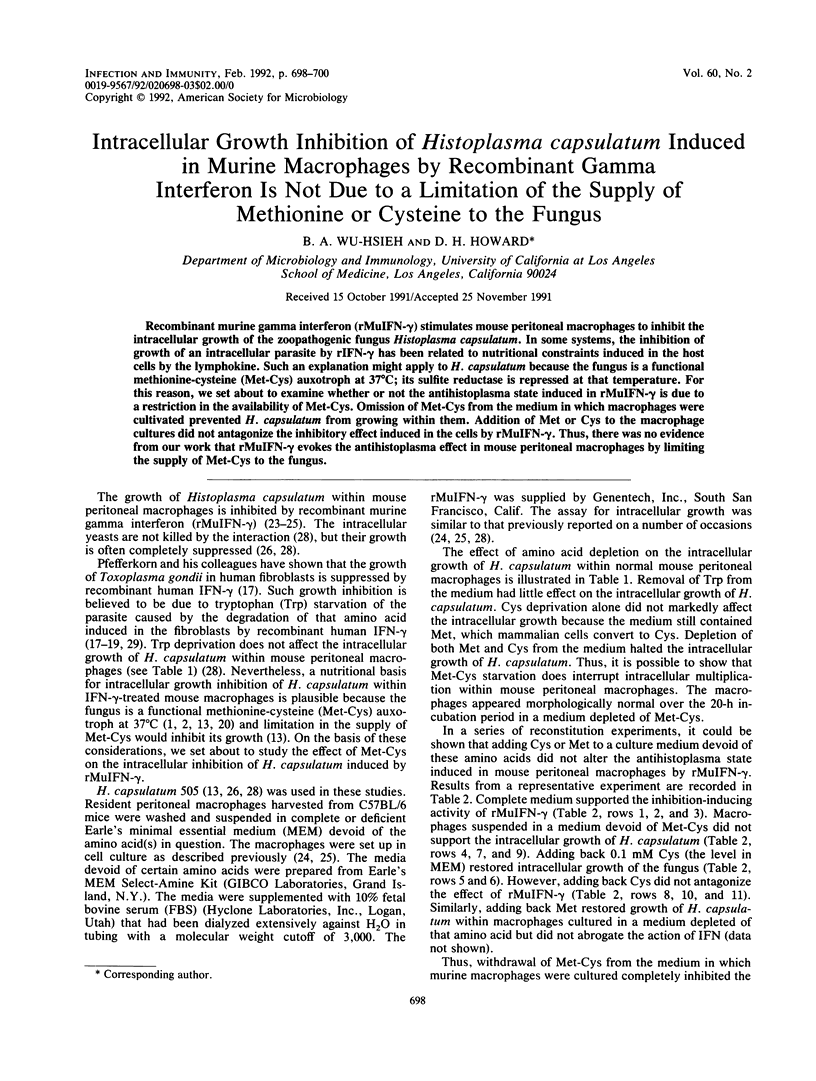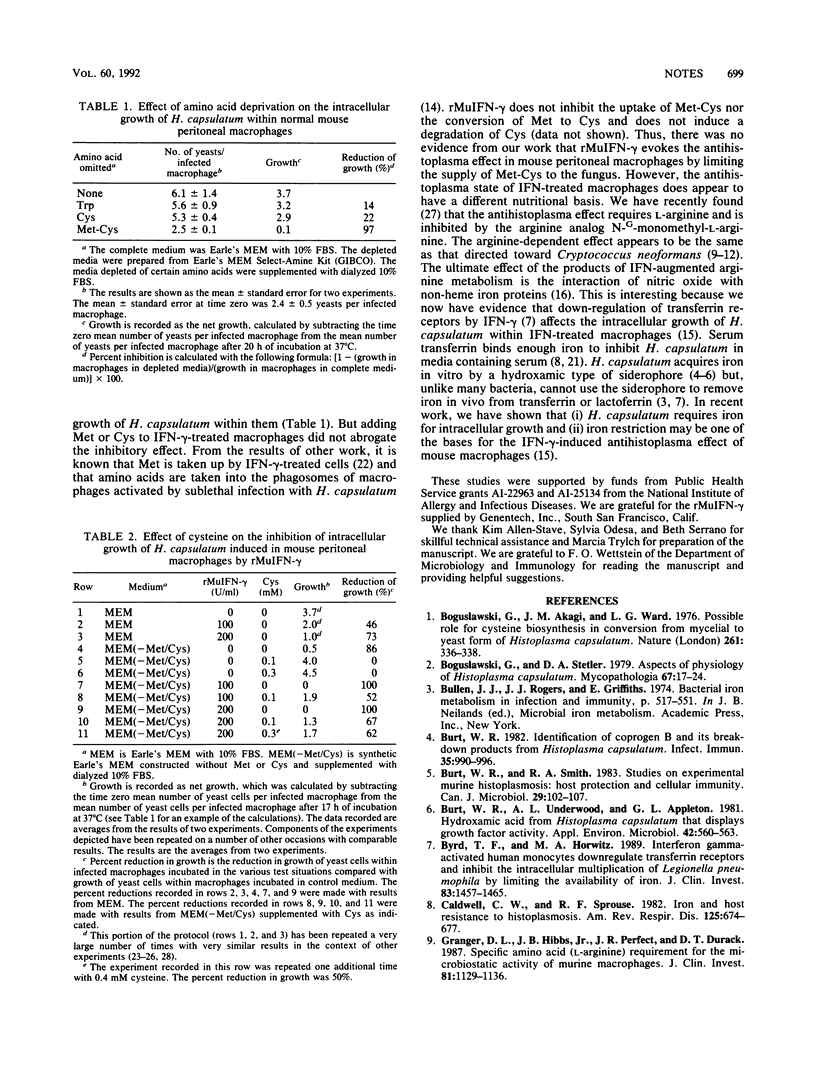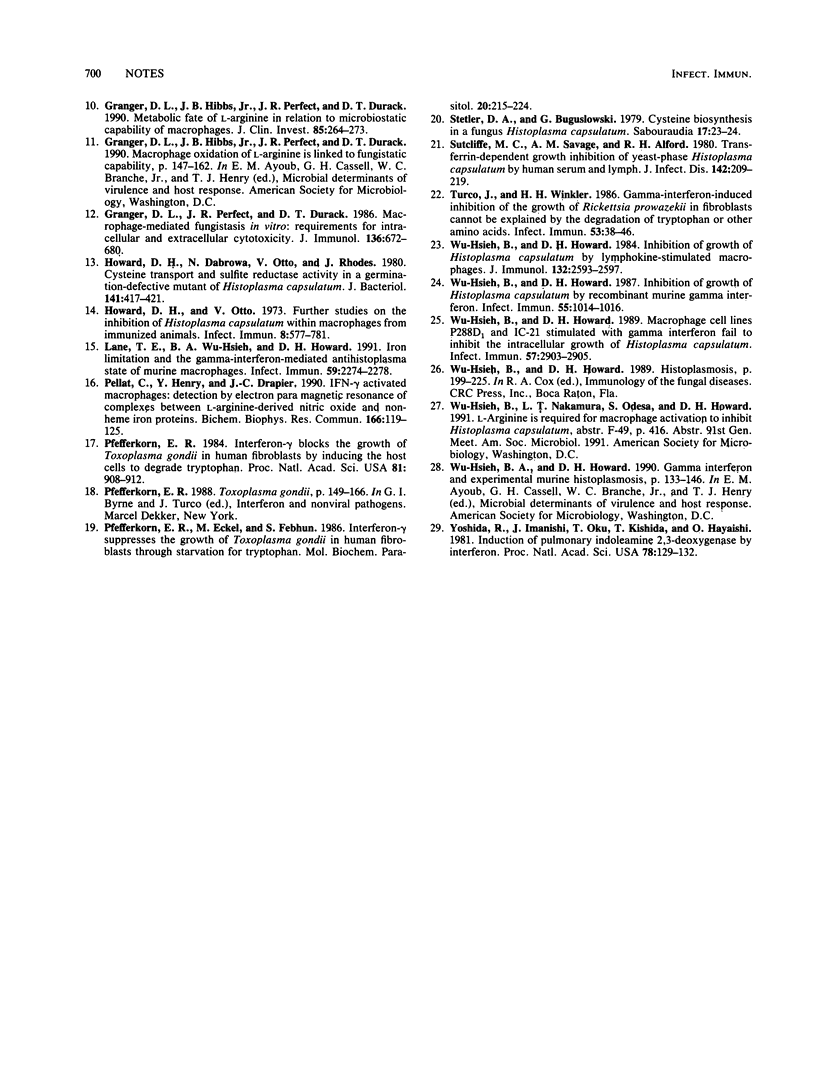Abstract
Recombinant murine gamma interferon (rMuIFN-gamma) stimulates mouse peritoneal macrophages to inhibit the intracellular growth of the zoopathogenic fungus Histoplasma capsulatum. In some systems, the inhibition of growth of an intracellular parasite by rIFN-gamma has been related to nutritional constraints induced in the host cells by the lymphokine. Such an explanation might apply to H. capsulatum because the fungus is a functional methionine-cysteine (Met-Cys) auxotroph at 37 degrees C; its sulfite reductase is repressed at that temperature. For this reason, we set about to examine whether or not the antihistoplasma state induced in rMuIFN-gamma is due to a restriction in the availability of Met-Cys. Omission of Met-Cys from the medium in which macrophages were cultivated prevented H. capsulatum from growing within them. Addition of Met or Cys to the macrophage cultures did not antagonize the inhibitory effect induced in the cells by rMuIFN-gamma. Thus, there was no evidence from our work that rMuIFN-gamma evokes the antihistoplasma effect in mouse peritoneal macrophages by limiting the supply of Met-Cys to the fungus.
Full text
PDF


Selected References
These references are in PubMed. This may not be the complete list of references from this article.
- Boguslawski G., Akagi J. M., Ward L. G. Possible role for cysteine biosynthesis in conversion from mycelial to yeast form of Histoplasma capsulatum. Nature. 1976 May 27;261(5558):336–338. doi: 10.1038/261336a0. [DOI] [PubMed] [Google Scholar]
- Boguslawski G., Stetler D. A. Aspects of physiology of Histoplasma capsulatum. (A review). Mycopathologia. 1979 Mar 30;67(1):17–24. doi: 10.1007/BF00436235. [DOI] [PubMed] [Google Scholar]
- Burt W. R. Identification of coprogen B and its breakdown products from Histoplasma capsulatum. Infect Immun. 1982 Mar;35(3):990–996. doi: 10.1128/iai.35.3.990-996.1982. [DOI] [PMC free article] [PubMed] [Google Scholar]
- Burt W. R., Smith R. A. Studies on experimental murine histoplasmosis: host protection and cellular immunity. Can J Microbiol. 1983 Jan;29(1):102–107. doi: 10.1139/m83-016. [DOI] [PubMed] [Google Scholar]
- Burt W. R., Underwood A. L., Appleton G. L. Hydroxamic acid from Histoplasma capsulatum that displays growth factor activity. Appl Environ Microbiol. 1981 Sep;42(3):560–563. doi: 10.1128/aem.42.3.560-563.1981. [DOI] [PMC free article] [PubMed] [Google Scholar]
- Byrd T. F., Horwitz M. A. Interferon gamma-activated human monocytes downregulate transferrin receptors and inhibit the intracellular multiplication of Legionella pneumophila by limiting the availability of iron. J Clin Invest. 1989 May;83(5):1457–1465. doi: 10.1172/JCI114038. [DOI] [PMC free article] [PubMed] [Google Scholar]
- Caldwell C. W., Sprouse R. F. Iron and host resistance in histoplasmosis. Am Rev Respir Dis. 1982 Jun;125(6):674–677. doi: 10.1164/arrd.1982.125.6.674. [DOI] [PubMed] [Google Scholar]
- Granger D. L., Hibbs J. B., Jr, Perfect J. R., Durack D. T. Metabolic fate of L-arginine in relation to microbiostatic capability of murine macrophages. J Clin Invest. 1990 Jan;85(1):264–273. doi: 10.1172/JCI114422. [DOI] [PMC free article] [PubMed] [Google Scholar]
- Granger D. L., Hibbs J. B., Jr, Perfect J. R., Durack D. T. Specific amino acid (L-arginine) requirement for the microbiostatic activity of murine macrophages. J Clin Invest. 1988 Apr;81(4):1129–1136. doi: 10.1172/JCI113427. [DOI] [PMC free article] [PubMed] [Google Scholar]
- Granger D. L., Perfect J. R., Durack D. T. Macrophage-mediated fungistasis in vitro: requirements for intracellular and extracellular cytotoxicity. J Immunol. 1986 Jan;136(2):672–680. [PubMed] [Google Scholar]
- Howard D. H., Dabrowa N., Otto V., Rhodes J. Cysteine transport and sulfite reductase activity in a germination-defective mutant of Histoplasma capsulatum. J Bacteriol. 1980 Jan;141(1):417–421. doi: 10.1128/jb.141.1.417-421.1980. [DOI] [PMC free article] [PubMed] [Google Scholar]
- Howard D. H. Further studies on the inhibition of Histoplasma capsulatum within macrophages from immunized animals. Infect Immun. 1973 Oct;8(4):577–581. doi: 10.1128/iai.8.4.577-581.1973. [DOI] [PMC free article] [PubMed] [Google Scholar]
- Lane T. E., Wu-Hsieh B. A., Howard D. H. Iron limitation and the gamma interferon-mediated antihistoplasma state of murine macrophages. Infect Immun. 1991 Jul;59(7):2274–2278. doi: 10.1128/iai.59.7.2274-2278.1991. [DOI] [PMC free article] [PubMed] [Google Scholar]
- Pellat C., Henry Y., Drapier J. C. IFN-gamma-activated macrophages: detection by electron paramagnetic resonance of complexes between L-arginine-derived nitric oxide and non-heme iron proteins. Biochem Biophys Res Commun. 1990 Jan 15;166(1):119–125. doi: 10.1016/0006-291x(90)91919-j. [DOI] [PubMed] [Google Scholar]
- Pfefferkorn E. R., Eckel M., Rebhun S. Interferon-gamma suppresses the growth of Toxoplasma gondii in human fibroblasts through starvation for tryptophan. Mol Biochem Parasitol. 1986 Sep;20(3):215–224. doi: 10.1016/0166-6851(86)90101-5. [DOI] [PubMed] [Google Scholar]
- Pfefferkorn E. R. Interferon gamma blocks the growth of Toxoplasma gondii in human fibroblasts by inducing the host cells to degrade tryptophan. Proc Natl Acad Sci U S A. 1984 Feb;81(3):908–912. doi: 10.1073/pnas.81.3.908. [DOI] [PMC free article] [PubMed] [Google Scholar]
- Stetler D. A., Boguslawski G. Cysteine biosynthesis in a fungus, Histoplasma capsulatum. Sabouraudia. 1979 Mar;17(1):23–34. doi: 10.1080/00362177985380041. [DOI] [PubMed] [Google Scholar]
- Sutcliffe M. C., Savage A. M., Alford R. H. Transferrin-dependent growth inhibition of yeast-phase Histoplasma capsulatum by human serum and lymph. J Infect Dis. 1980 Aug;142(2):209–219. doi: 10.1093/infdis/142.2.209. [DOI] [PubMed] [Google Scholar]
- Turco J., Winkler H. H. Gamma-interferon-induced inhibition of the growth of Rickettsia prowazekii in fibroblasts cannot be explained by the degradation of tryptophan or other amino acids. Infect Immun. 1986 Jul;53(1):38–46. doi: 10.1128/iai.53.1.38-46.1986. [DOI] [PMC free article] [PubMed] [Google Scholar]
- Wu-Hsieh B. A., Howard D. H. Inhibition of the intracellular growth of Histoplasma capsulatum by recombinant murine gamma interferon. Infect Immun. 1987 Apr;55(4):1014–1016. doi: 10.1128/iai.55.4.1014-1016.1987. [DOI] [PMC free article] [PubMed] [Google Scholar]
- Wu-Hsieh B., Howard D. H. Inhibition of growth of Histoplasma capsulatum by lymphokine-stimulated macrophages. J Immunol. 1984 May;132(5):2593–2597. [PubMed] [Google Scholar]
- Wu-Hsieh B., Howard D. H. Macrophage cell lines P388D1 and IC-21 stimulated with gamma interferon fail to inhibit the intracellular growth of Histoplasma capsulatum. Infect Immun. 1989 Sep;57(9):2903–2905. doi: 10.1128/iai.57.9.2903-2905.1989. [DOI] [PMC free article] [PubMed] [Google Scholar]
- Yoshida R., Imanishi J., Oku T., Kishida T., Hayaishi O. Induction of pulmonary indoleamine 2,3-dioxygenase by interferon. Proc Natl Acad Sci U S A. 1981 Jan;78(1):129–132. doi: 10.1073/pnas.78.1.129. [DOI] [PMC free article] [PubMed] [Google Scholar]


